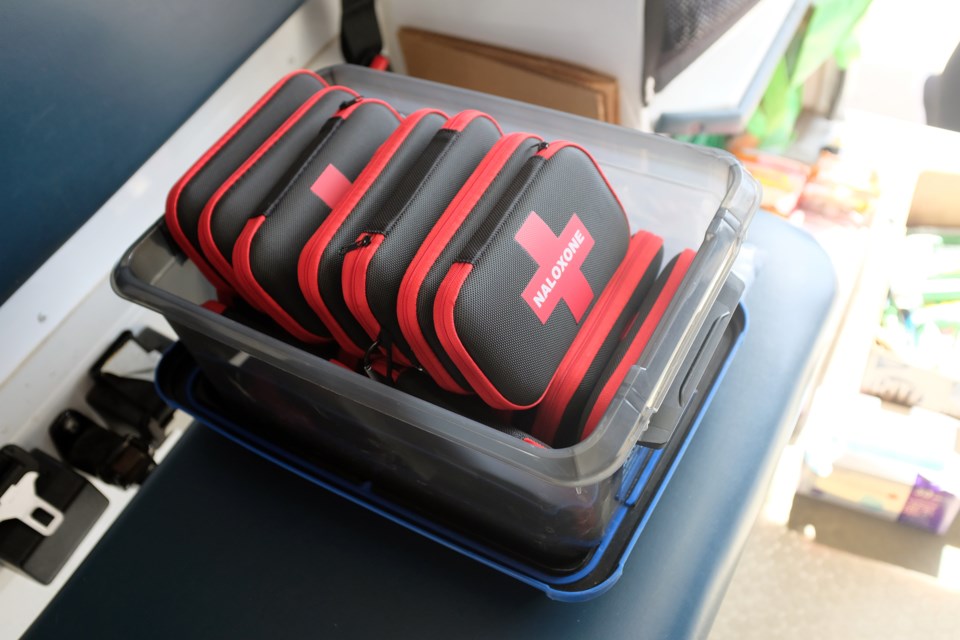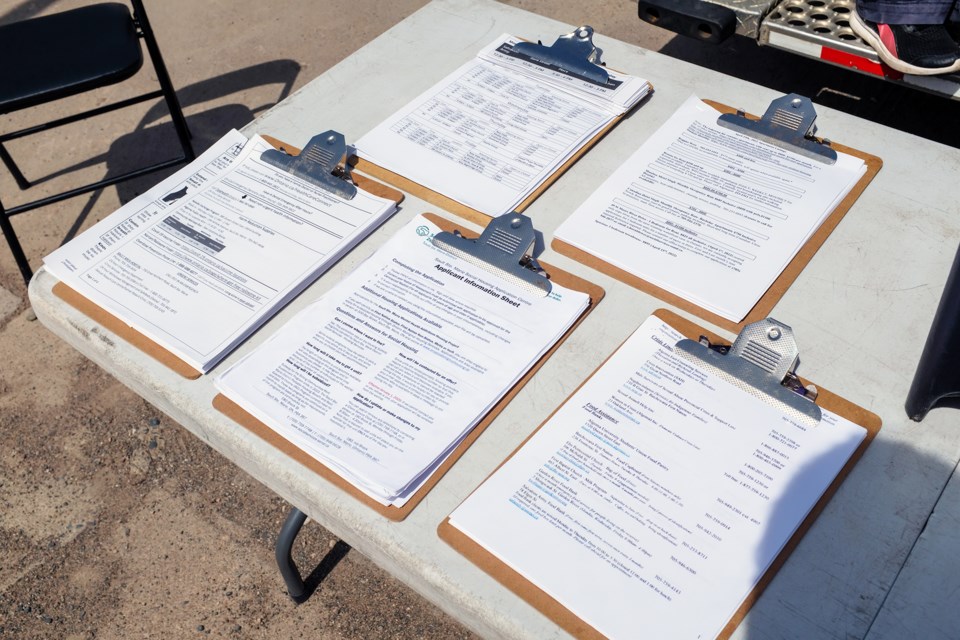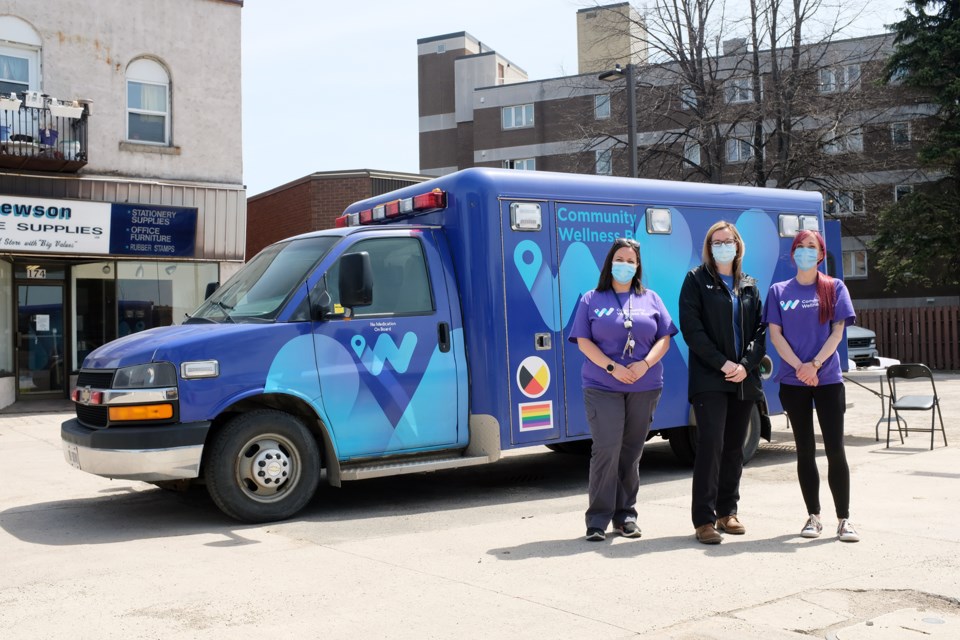A pilot project that converted an ambulance on a shoestring budget to bring primary health care and harm reduction to some of Sault Ste. Marie’s most vulnerable has been in operation for one full year. Now, community partners are seeking a more permanent source of funding to keep it in operation well into the future and possibly expand the program.
The Community Wellness Bus project began with an idea during one of the most challenging parts of the COVID-19 pandemic, said Annette Katajamaki, CEO of Canadian Mental Health Association (CMHA) Algoma.
“We realized these very vulnerable people — typically many were homeless, many had mental health and addictions issues — were really not getting any services because many of them don’t have access to physician care and many of them live in the downtown core and many of our health services are not in the downtown core,” said Katajamaki.
At the exact same time, another crisis was affecting that same population in Sault Ste. Marie.
“It was also a time when the opioid crisis was really coming to light and not in a positive light, unfortunately,” said Katajamaki. “It was all about ‘why don’t these people just stop using? What are we going to do with them?’ as opposed to ‘how have we failed as a community in helping folks get better or taking steps toward recovery?’”

Instead of going through the lengthy process of writing proposals and seeking a funding source, CMHA determined what it could do with existing resources and the help of four partner agencies — Algoma Family Services, Sault Area Hospital (SAH), the Superior Family Health Team and Social Services Sault Ste. Marie.
That collaboration resulted in the Community Wellness Bus project in which a former ambulance staffed with members from partner agencies brings health care and harm reduction supplies directly to vulnerable people in the city.
The bus makes scheduled stops at locations like the Soup Kitchen Community Centre, Salvation Army, Pauline’s Place and St. Vincent Place, among others. The on-board team can vary from stop to stop, but typically includes a nurse, a social worker and a peer support worker, among others.
“We recognized early on that there isn’t a lot of trust in the health care system from these folks that are living in vulnerable situations,” said Katajamaki. “They have been screwed lots of times, so we knew part of what we had to do is develop relationships and develop engagement with them and one of the ways that we have to do it is to go to them and not expect them to come to us.”
“We have to be open to providing what they need, what they want, when they want it, where they happen to be,” she added.
Since launching in April of 2021, the bus has had more than 5,000 visits from people looking for a light snack, harm reduction supplies, naloxone, wound care or just someone to talk to.
Erin McCaig is a harm reduction outreach nurse at SAH who can be found on the bus a few days a week. She said the team working on the bus is working to build up the trust of the people it serves.
“Most patients in this population don’t trust health care providers. They have a lot of reasons for that, because of stigma and bad encounters,” said McCaig.
“Primary care is a problem and follow up care is a massive problem,” she added. “Most of these patients don’t have phones or addresses, there is a lot of couch surfing. So even if they are not technically homeless because they stay at a friend’s house, they don’t have a residence, so how do you contact them?”
McCaig worked for years as a nurse in the emergency department at SAH and said some of the wounds she has seen working on the bus have been just as bad as ones she saw in the ED.
The bus is stocked with all of the items you would expect in any clinical setting, like bandages, anti-bacterial creams and splints and McCaig carries a bag with a defibrillator, similar to what a paramedic would have on-hand to treat patients.
“I wasn’t really sure what I would get initially — I have gotten everything from a minor scratch to third-degree burns, gunshot wounds and stab wounds,” said McCaig.
Intravenous drug users can often have skin infections that can get out of control if not treated promptly. Treating those wounds on the bus can save the health care system countless dollars because many of the patients it sees would put off going to hospital until they became more serious or got infected.
“They may even go into sepsis, which can be deadly, because that’s when the infection has spread system wide, it’s in your blood and it starts to affect blood pressure, heart rate and you could actually die,” said McCaig. “When you factor in the costs of an ICU admission, the cost of an air transfer, all for what essentially started off as a very simple skin infection. So if you have that level of intervention, you save the health care system thousands of dollars.”

Most people who show up to the bus come for a light snack, basic toiletries or harm reduction supplies, which can include clean needles for intravenous drug users or kits for using methamphetamine.
“Harm reduction supplies have never been shown to increase use. It’s the same as condoms. When we started giving condoms out in schools it wasn’t shown that it was causing teenagers to have sex. Teenagers were already having sex, we just made it safer and prevented teen pregnancy,” said McCaig.
She said harm reduction strategies are used in every aspect of our lives, from seat belts and helmets to regulating the hours alcohol can be sold at stores and restaurants.
“Those are all controlled harm reduction measures. Harm reduction is everywhere, this is just a little more stigmatized,” said McCaig. “Harm reduction supplies do not increase their chances of using. All we are doing is giving them safe supplies and decreasing disease rates. We are also trying to engage with them and build a rapport and trust so maybe they will be ready to talk next time, maybe they will consider treatment. That has been proven more effective than anything else, if you look at research.”
McCaig said she has heard concerns from people about giving people living with addictions free needles or naloxone, while the general public has to pay for needles used to inject insulin or Epi-Pens to treat severe allergic reactions.
The idea behind harm reduction is to keep people as safe as possible while doing drugs.
“We give safe supplies. We don’t give the drug, we just give the safe supplies to do the drug. One thing we try to encourage is a new needle every time because that is going to decrease infections and it’s going to decrease transmissions of Hep C and HIV,” said McCaig.

A naloxone kit, also known as Narcan, is available for free to anyone at a pharmacy or the Community Wellness Bus and is used to reverse an opioid overdose. The cost to the Ontario health care system is about $120 per kit.
Aside from potentially saving a life, McCaig said that $120 cost to the health care system for the naloxone can end up saving thousands in the end.
“They reverse the overdose right at the site and then they never come to hospital. They never get admitted. There’s no NarCan drip, there’s no ICU admission. That ICU bed is now used for somebody who was in a trauma or something that wasn’t preventable,” she said. “Epi-Pens shouldn’t be $700. I do think diabetic supplies should be covered, I also think we should save money for the health care system by using Narcan.”
Another concern McCaig has heard from the community is about the needles that can sometimes be found on the ground in some areas serviced by the bus and in other parts of the city.
”Obviously it’s is a huge safety concern and I would not be happy about that if I found it myself at a park where a child is playing,” said McCaig.
The workers on the bus do hand out sharps containers and teach clients how to use a 2L pop bottle as another way to store used needles.
“I think the solution to that is bigger than this bus. Quite frankly, these people are going to do drugs no matter what. What we need is more needle disposal areas,” said McCaig.
One of the key ways in which the Community Wellness Bus builds rapport and trust with the clients it serves is through peer support workers — people with lived experience with addiction.
Amy Lebreton is one of the CMHA peer support workers who has been working on the bus for about six months.
“I was in the day treatment program up at the hospital and it was actually my counsellor who saw the job posting for this and said I would be perfect for it,” said Lebreton. “I have my business diploma but I never worked in social services, but ever since I started working here I realized this is where I should have been the whole time.”

Lebreton often has difficult but rewarding conversations with people, giving them the tools they need to stay safe while sharing her own story of recovery, a story she says is still being written.
“Our job isn’t to provide stuff just for people to get high. It’s to help empower them to better their lives. It’s all about those small steps. That’s why we entice people with the snacks and the juice, we are trying to build those connections with people and get their trust back, because a lot of these people have had horrible experiences in the community,” said Lebreton. “We don’t just give them items and send them on their way, we are providing them with information on how to use safely, how to get off them, so they aren’t injuring themselves.”
She said the team is trying to make positive connections with people on a step-by-step basis, so even if the client isn’t ready to start recovery on that day, they know where to go when they need help to start.
“We have to drop the stigma that because you are an addict that you are a bad person. That is so not the case,” said Lebreton. “I have met the smartest, kindest, best people and they have a disease. That’s the big thing that is so hard for people to wrap their heads around.”
Katajamaki can’t say enough about the team who works on the bus week in and week out.
“These people who work on the bus are passionate about what they do and their hearts are definitely in the right place,” said Katajamaki. “It’s so invigorating as a leader to see this team coming together from different agencies — we all have different policies, we all have different rules, job descriptions and all get paid differently — but together they figured out how to make it work.”
Adjustments have been made a number of times over the one year the bus has been in service to better gear the program for the clients it serves.
“We are not naive to think we have done everything perfectly, we absolutely haven’t, but we feel like we are making a difference and it sounds like, from the clients we have talked to, that we are making a difference,” she said.
The bus also accepts donations of everything from deodorant and shampoo to feminine hygiene products and granola bars. Cash donations can also be made and Katajamaki said donation receipts can be given in return.
Anyone interested in donating goods or funds can email [email protected] to the attention of Annette Katajamaki.
Similar programs in other municipalities are often funded by the provincial government, but the Sault’s Community Wellness Bus was put together using only existing resources and a $20,000 Bell Let’s Talk Community Grant. Katajamaki hopes stable government funding will follow the successes seen so far and possibly help to expand it to operate outside of the city in other parts of the Algoma District.
“I want it to be a vehicle of hope,” said Katajamaki. “I hope that is what people see when they come to the bus. Not just that they can get some food here and there is somebody to talk to, but I am hoping it’s also a hopeful sign for them. Somebody still believes in me, somebody thinks I am a worthwhile human being and that is important. We all have to feel wanted and a part of community.”
